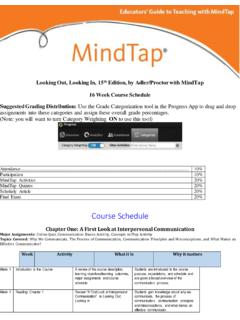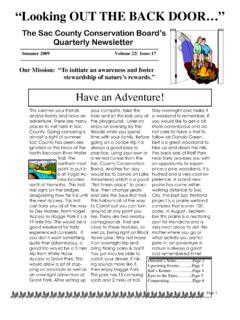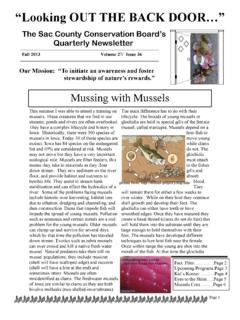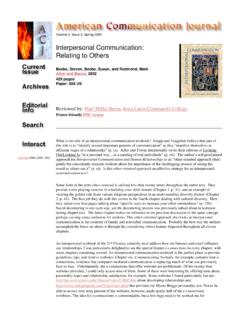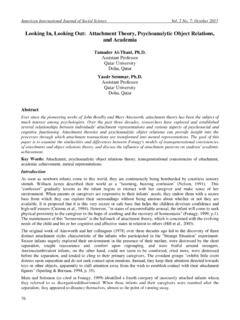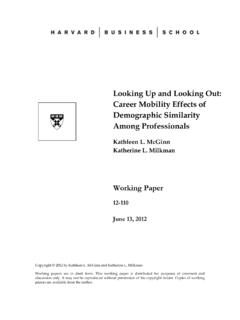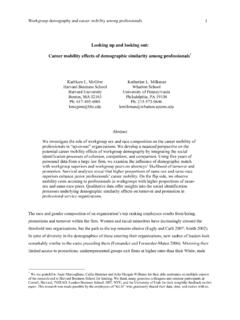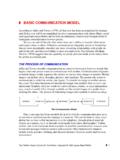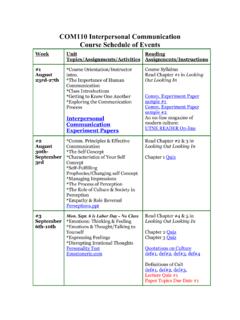Transcription of 11. LESSON PLAN - Looking Out for Sarah
1 LESSON PLAN: Looking OUT FOR Sarah Written and illustrated by Glenna Lang Objectives: Students will be able to understand the training of guide dogs. Students will be able to appreciate and understand the importance of guide dogs for people with disabilities. New York State Learning Standards: Pre- Kindergarten: 1- 7, 10, 11 Kindergarten; 1- 7, 9- 11 First Grade: 1- 7, 9, 11 Second Grade: 1- 7, 11 Materials: Looking Out for Sarah , United States map, chart paper, Museum of disABILITY History website: Vocabulary: harness guitar piano Boston reporter camera guide New York City blind train errand publicity hound Before Reading: Read Looking Out for Sarah and review the Therapeutic Animals PowerPoint located on the Museum of disABILITY History website: Guide students through a picture walk of the book. Tell them that this story is about a guide dog named Perry and how he helps and takes care of his owner Sarah . Read the page at the end of the story called, About the Characters.
2 Have students think of questions they have about Perry and Sarah . List these on the chalkboard for students to consider as they listen to the story. Reading: Read Looking Out for Sarah aloud to the class. Discuss the role of service and guide dogs for people with disabilities using the five W's (who, what, where, when, and why). What sort of tasks are service dogs trained for? Who do service dogs assist? Where do service dogs receive training? When was the use of service dogs first established? Why is the work of a service dog important? Discussion Questions: Ask students the following questions so they can reflect and think critically about the story: Pages 1- 3: Who is Perry? What does Sarah do when she wakes up? Pages 4- 5: How do we know when Perry is working? Why is Perry Looking out for Sarah ? Pages 6- 7: What kinds of commands does Sarah use when Perry is working? What sort of things does Perry have to watch out for? Pages 8- 9: Where do Perry and Sarah go?
3 Why is Perry allowed inside stores with Sarah ? Pages 10- 11: How does Perry help Sarah when she goes to the post office? What did Perry do when they returned home? Pages 12- 13: Where did they go after Perry's nap? What did Perry do to help Sarah when it was time to get off the train? Pages 14- 15: What does Sarah do with the children in the classroom? Pages 16- 17: What does Sarah talk about with the children at school? Why did Sarah and Perry walk from Boston to New York? Why were the children asked not to pet Perry while he was working? Pages 18- 19: What does Perry dream about while sleeping? How did people show their support for Sarah and Perry during their walk? Pages 20- 21: Why do you think reporters and photographers wanted to talk to Sarah during the walk? Reporters asked Sarah many questions. What would you have asked her? What does the author mean when she says Perry's not a publicity hound? What award did Sarah and Perry receive?
4 Pages 22- 23: Where did Sarah and Perry go after their visit to the school? Why does Sarah remove Perry's harness before he plays? What games do they play in the park? What is Perry's favorite thing in the world? Pages 24- 25: What does Perry do when he hears Sarah call, Perry, come! What does this tell you about how Perry felt about going home? Pages 26- 27: What happens after Perry and Sarah have dinner? What musical instruments does Sarah play? What does Perry do to show Sarah he enjoys the music she is playing? Page 28: Where does Perry sleep? Why? How does he feel at the end of the day? Page 29: How old was Perry when he went with Sarah on the walk from Boston to New York? What special training did Perry receive in order to become a guide dog? When was Perry trained to become a guide dog? How far did Sarah and Perry walk between Boston and New York? Guided Practice: Guide students in locating Boston and New York on a map of the United States and help them calculate the distance that Sarah and Perry traveled.
5 Younger students can locate New York and New York City as well as Massachusetts and Boston on the map. The author of this book, Glenna Lang, uses imagery to show how Perry uses his five senses. Write the following five senses on a chart: Sight, Smell, Touch, Taste, and Hearing. o Have students find examples of Perry using each of these in the book such as: Sight: He squinted happily when she groomed that place on his back that he never could reach; he made sure to look up high so that Sarah would not hit her head on branches. Hearing: When his harness was on, he was working and had to listen carefully for directions; Sarah 's singing tingled Perry's ears; the sounds rang round and mellow. Smell: Their hands, smelled like peanut butter and jelly, or tuna fish; the smell of the tennis ball made his tail swing wildly; Sarah 's shoes still had a faint aroma of train station, dinner rolls, and grass. Touch: He snuggled against several laps and enjoyed the gentle hands stroking his fur; Perry liked the rocking motion of the train.
6 Taste: He quietly took care of them (crumbs) while glancing up at Sarah ; inside their house, Perry lapped cool water from his bowl. o Have students write examples they find under each category. For younger students, use a picture to indicate each of the senses on the chart paired with the word and read each of the examples for them to pair with one of the senses. Closure: Guide students with brainstorming questions that they would like to ask Sarah and Perry. Introduce or review the basics of writing a letter. Compose a group letter to author Glenna Lang. Author contact: Bonus Activity: For students in Grades 2 and up: What other types of things do people do with their service animals? Use the Museum of disABILITY History website: Bibliography: Lang, Glenna. Looking Out for Sarah . Watertown, MA: Charlesbridge, 2003.
